Stanton Harcourt
| Stanton Harcourt | |
| Oxfordshire | |
|---|---|
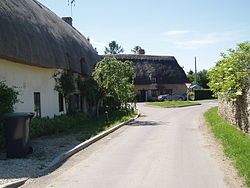 Cottages in Stanton Harcourt | |
| Location | |
| Grid reference: | SP4105 |
| Location: | 51°44’56"N, 1°24’7"W |
| Data | |
| Population: | 960 (2011) |
| Post town: | Witney |
| Postcode: | OX29 |
| Dialling code: | 01865 |
| Local Government | |
| Council: | West Oxfordshire |
| Parliamentary constituency: |
Witney |
Stanton Harcourt is a village in Oxfordshire about four miles southeast of Witney and about six miles west of Oxford. The 2011 Census recorded the parish's population as 960.
The name 'Stanton' is from the Old English stan tun: stone-village, probably after the prehistoric stone circle known as the Devil's Quoits, southwest of the village.[1] The site is a scheduled monument.[2] The suffix 'Harcourt' is after Robert de Harcourt of Bosworth in Leicestershire inherited lands of his father-in-law at Stanton in 1191.[3]
Archaeology
Within the parish of Stanton Harcourt is a series of palaeochannel deposits buried beneath the second (Summertown-Radley) gravel terrace of the River Thames. The deposits have been attributed to marine isotope stages and have been the subject of archaeological and palaeontological research.[4] Evidence was found for the co-existence of species of elephant and mammoth during interglacial conditions, disproving the widely held view that mammoths were an exclusively cold-adapted species.
Harcourt Manor
The Domesday Book of 1086 records that the manor was held by Odo, Bishop of Bayeux.[3]
Harcourt Manor was originally an unfortified manor built between the late 14th and mid 15th centuries and set around a courtyard. Its gatehouse was added about 1540.
During the 17th century the manor was abandoned by the Harcourt family and in the mid-18th century, stone from the demolished parts of the house were used in the new family seat at Nuneham. All that remains of the original house is the Great Kitchen, with crenellated parapet and louvered octagonal roof replaced in 1485 and parts of the service wing. The service wing also dates to the 15th century and has since become a farmhouse. Pope's Tower, attached to the chapel, also survives and is discussed in another record.
The Harcourt family moved back to the property in the mid-20th century and occupy the former gatehouse of 1540, heavily converted in the 19th century.[5] Harcourt House is a Grade II* listed building.[6]
The Great Kitchen is a separate building from the house, built in 1485, possibly incorporating an earlier building. The kitchen and is Grade I listed.[7] The service range attached to the south of the Great Kitchen is also 15th-century. It has been converted into a house, Manor Farmhouse, and is Grade I listed.[8]
Pope's Tower in the grounds of Harcourt House was built about 1470–71, probably by the master mason William Orchard.[9] It is a Grade I listed building.[10] The tower acquired its name centuries later, after the poet Alexander Pope stayed here in 1717–18 and used the solitude of its upper room to translate the fifth volume of Homer's Iliad. In the summer of 1718 he also wrote the epitaph to a young couple, John Hewett and Sarah Drew, who were struck by lightning and killed in the parish: the poem is carved on a stone monument on the outside of the south wall of the nave or St Michael's parish church.
Parish church
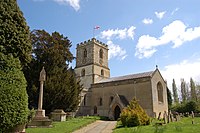
The earliest known record of the parish church of St Michael dates from 1135, and the Norman[11] nave and lower parts of the bell tower are certainly 12th century.[12]
In the 13th century the chancel, chancel arch and tower arches were rebuilt[11] and the transepts and stair turret were added.[12] In the 15th century the upper part of the belltower was completed, the Perpendicular Gothic west window of the nave and north and south windows of the transepts were inserted[13] and the pitch of the roof was lowered.[12] The Harcourt chapel was added on the south side of the chancel, possibly by William Orchard.
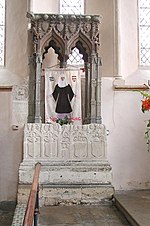
In the chancel is the Decorated Gothic late 13th- or early 14th-century shrine of St Edburg of Bicester. It was at the Augustinian priory at Bicester until 1536, when the priory was dissolved. Sir James Harcourt had the shrine salvaged and moved to St Michael's.
St Michael's is a Grade I listed building.[14]
RAF Stanton Harcourt
In the Second World War there was a Royal Air Force airfield at Stanton Harcourt. It is notable for having been a transit point for Winston Churchill and for being a starting point for a bomber raid on the German battleship Scharnhorst. The runways are, for the most part, now gone, but some of the original buildings remain including a turret trainer, crew room and various other buildings. The hangars have been converted into office and industrial units.
Amenities
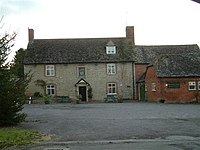
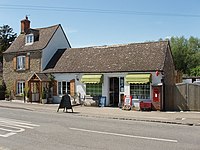
Stanton Harcourt has a 17th-century pub, The Harcourt Arms.[15] It had another pub, the Fox, but it is now a private home. The parish council owns Fox Field behind it and has renamed it the Jubilee Field, intending to install play equipment. Trees and hedging have been provided by the Woodland Trust and planted by volunteers.
The parish has a primary school; Stanton Harcourt CE Primary School.
Outside links
| ("Wikimedia Commons" has material about Stanton Harcourt) |
- Stanton Harcourt – WW2 Airfields of Oxfordshire
- Stanton Harcourt Oxfordshire – A vision of Britain through time
References
- ↑ Crossley & Elrington 1990, pages 267–274
- ↑ National Heritage List 1006359: The Devil's Quoits
- ↑ 3.0 3.1 Crossley & Elrington 1990, pages 274–281
- ↑ Buckingham, Roe & Scott 1996
- ↑ National Monuments Record: No. 983996 – Harcourt Manor
- ↑ National Heritage List 1199690: Harcourt House and attached walls and outbuildings
- ↑ National Heritage List 1053135: The Great Kitchen south of Harcourt House
- ↑ National Heritage List 1283234: Manor Farmhouse south of Harcourt House
- ↑ Sherwood & Pevsner 1974, p. 782.
- ↑ National Heritage List 1053134: Pope's Tower south east of Harcourt House
- ↑ 11.0 11.1 Sherwood & Pevsner 1974, p. 778.
- ↑ 12.0 12.1 12.2 Crossley & Elrington 1990, pages 289–293
- ↑ Sherwood & Pevsner 1974, p. 779.
- ↑ National Heritage List 1053164: Church of St Michael
- ↑ The Harcourt Arms
Books
- Barclay, Gill; Gray, Margaret; Lambrick, George (1995). Excavations at the Devil's Quoits, Stanton Harcourt. Thames Valley Landscape Series. 5. Oxford: University of Oxford School of Archaeology. ISBN 0-947816-84-4.
- Buckingham, C; Roe, D; Scott, K (1996). "A preliminary report on the Stanton Harcourt Channel Deposits (Oxfordshire, England)". Journal of Quaternary Science 11 (5).
- A History of the County of Oxford Volume 12: Wootton Hundred (South) including Woodstock - Victoria County History
- Lambrick, George; Allen, Tim (2004). Gravelly Guy: Excavations at Stanton Harcourt. Thames Valley Landscape Series. 21. Oxford: Oxford University School of Archaeology. ISBN 0-947816-66-6.
- McGavin, Neil; Symonds, Robin P; Harman, Mary (1980). "A Roman Cemetery and Trackway at Stanton Harcourt". Oxonensia (Oxfordshire Architectural and Historical Society) XLV: 112–123. http://oxoniensia.org/volumes/1980/mcgavin.pdf.
- Mills, A.D.; Room, A. (2003). A Dictionary of British Place-Names. Oxford: Oxford University Press. ISBN 0-19-852758-6.
- Sherwood, Jennifer; Pevsner, Nikolaus (1974). Oxfordshire. The Buildings of England. Harmondsworth: Penguin Books. pp. 778–784. ISBN 0-14-071045-0.
